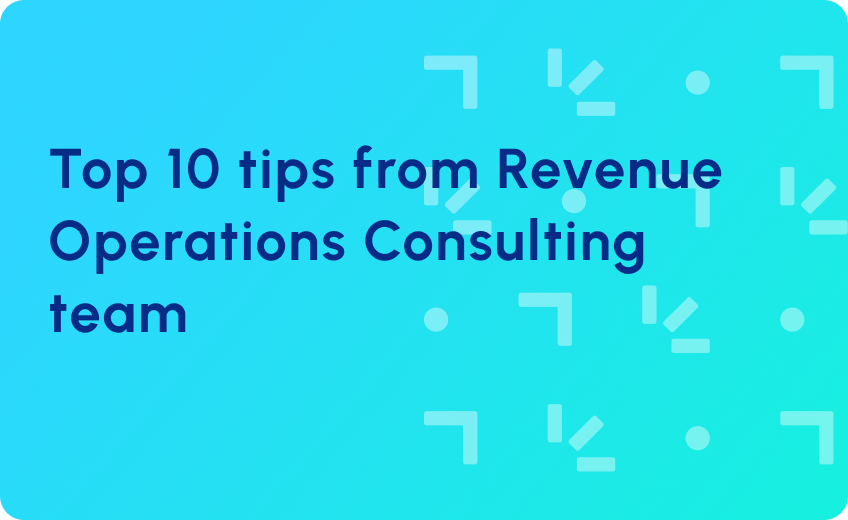
What Scalable RevOps Architecture Actually Looks Like
While your team is trying to untangle spreadsheets, Slack pings, and misaligned reports, someone else’s revenue is quietly getting faster, cleaner, and built to scale.
That’s the danger of waiting. Broken systems make growth harder, more expensive, and less predictable. The organizations that win are the ones that fix their architecture before they’re forced to.
Here’s what a scalable RevOps architecture really looks like and how building it right now can save you months of pain later.
1. A Defined Systems Hierarchy (What Lives Where)
Every scalable RevOps architecture starts by assigning clear roles to each system. No more debating where to put lifecycle data, campaign attribution, or deal tracking.
- CRM (Salesforce): The single source of truth for accounts, contacts, pipeline, and forecasting.
- MAP (HubSpot, Marketo, Eloqua): The engine for capturing, nurturing, scoring, and attribution.
- Data Layer: ETL or middleware (Segment, Workato, Hightouch) for syncing and business logic.
- BI / Reporting Layer: Tableau, Looker, or native CRM reporting for leadership-ready dashboards.
But can HubSpot and Salesforce work together reliably? Yes. But only if you follow HubSpot Salesforce integration best practices. That means consistent field mapping, conflict resolution rules, and sync monitoring as part of your RevOps systems design.
2. Centralized Governance for Fields, Lifecycle, and Logic
Without governance, scale equals chaos. If every department edits fields or lifecycle logic, data trust evaporates.
A scalable architecture defines:
- Field Dictionary: What every field means, who owns it, where it syncs.
- Lifecycle Governance: Documented rules for MQL, SQL, Opportunity, Customer stages.
- Access Controls: Who can edit what, in which platform, and under what conditions.
Pro tip: You need governance early. Otherwise, you’re likely to rip out bad data models under pressure. Whereas early governance is cheaper, faster, and protects your future reporting.
3. Modular Workflow Design
Instead of one giant “if-this-then-that” automation, build modular Hubspot workflows, having trigger-based sequences for scoring, routing, or notifying, centralized “router” programs to control where leads or accounts go next, and guardrails to stop loops and prevent overwriting valuable data.
This approach is faster to debug, easier to scale, and safer when onboarding new teams or products. Even for smaller teams, modular design isn’t overkill. Rather, it keeps small systems from breaking when you double headcount or add new markets. Scalable now = stable later.
4. Reporting That Aligns Sales, Marketing, and CS
A modern RevOps tech stack is only as good as the story its data can tell.
Your reporting layer must reconcile metrics across systems, map funnel movement across marketing, sales, and customer success, attribute campaigns to revenue with confidence, and monitor SLA compliance and lead velocity across regions and teams.
Standard dashboards include:
- Lifecycle Funnel: Volume and conversion rates.
- Multi-System Funnel Reporting: CS + marketing + sales alignment in one view.
- Source Attribution: Which campaigns actually influenced the pipeline.
- SLA Compliance: Follow-up speed by rep, region, or channel.
You can finally trust campaign ROI numbers, but only when attribution models are unified and data logic is consistent across every system in your RevOps stack.
5. Change Management Processes Baked In
Scalable doesn’t mean rigid. The best RevOps systems evolve without breaking.
That means building for safe iteration:
- Change request workflows for fields, scoring, routing, and dashboards.
- Version control for workflows and scoring logic.
- Sandbox testing before pushing updates live.
- Documentation every GTM team can access (and actually trust).
Pro tip: You can’t eliminate “shadow ops” (people making edits outside the process) entirely. But a clear request-and-approval framework plus transparent documentation makes off-the-record changes unnecessary.
Discover the Blueprint for Scalable RevOps Success
A scalable RevOps architecture assigns clear system roles, enforces lifecycle governance, and uses modular workflows instead of fragile automation chains. Reporting aligns marketing, sales, and CS with unified attribution and SLA tracking. Change management keeps growth safe with version control, testing, and documentation.
Together, you get a RevOps systems design that scales reliably, supports cross-team trust, and turns data into strategy. No endless rework or integration issues.
Need to build a scalable RevOps architecture right the first time? Our HubSpot RevOps consulting team designs scalable RevOps architecture and complete RevOps systems design frameworks for B2B companies that want growth without chaos.
Let’s build the system your competitors wish they had. Book your RevOps consult today!




